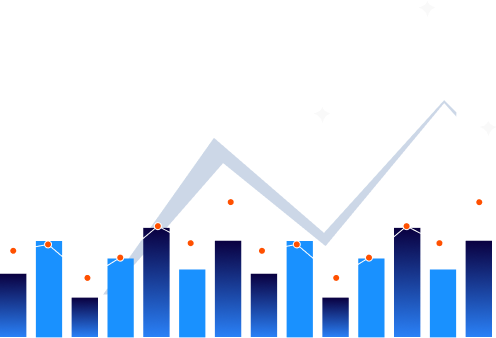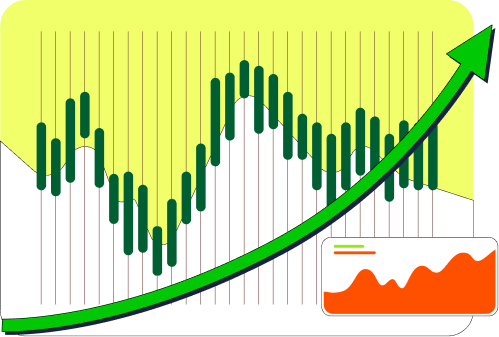Don’t get overwhelmed if you’re new to the world of investing. Here are some basic concepts for you to understand how investing really works and where you can find your place in it.
A good place to start. Get the low-down before you dive in.
At its core, investing is about putting your money into something, like stocks or gold, with the expectation that it’ll be worth more than what you paid; netting you a profit.
Think of investing as spending your money—or sometimes even your time and energy—on things you believe will grow in value. Like buying shares in a company you think will hit big, or putting your money into education, anticipating that it’ll pay off in your career. Investments aren’t just about money; they’re about where you choose to put your effort and resources, with the hope of getting more back in the future. But it’s not always a sunny day in the investment world. Sometimes, what you invest in might lose value, or the returns you were counting on, like rent from a property, might not come through. With the chance of making more comes the risk of ending up with less.
Investing is like gardening; you plant a seed in the hope it’ll grow into something bigger, whether it’s a fruit tree, a berry bush, or a beautiful flower. You’re betting on that seed to eventually give back more than what you started with. But just like in gardening, not every seed blossoms, and in investing, not every decision leads to profit. There’s always a chance of loss, alongside the potential for growth.
Imagine you’re using what you’ve got now – like savings or extra time – to grab something that could be worth more later on. That’s investing. Whether it’s putting cash into the stock market, buying a piece of land, or even learning a new skill, the hope is that whatever you’re investing in will grow in value. From stocks and bonds to gold or a piece of art, there are tons of ways people try to make their money work for them. At its heart, investing is about trying to get a bit more out of what you’ve put in, aiming for a bigger payoff down the line.

Imagine the world of investments as a gigantic buffet. You’ve got all sorts of dishes to try—some might be a bit spicy, others sweet, and a few might just have an acquired taste. Let’s walk through what’s on offer
These are like the main course of our investment feast. By buying stocks, you’re getting a little piece of a company. Think of it as owning a small share of your favorite restaurant. Stocks are always buzzing with excitement, much like the dish everyone talks about at a party. You buy them hoping they’ll become more valuable over time. If you sell them for more than you paid (after covering any fees), you’ve made a profit. Some stocks also give you dividends, which is a share of the company’s profits.
Here, you’re essentially lending money to a company or government, kind of like spotting a friend some cash. They promise to pay you back with a little extra for your trouble (interest). It’s a bit like a dependable dish that you know will be good every time. Bonds are typically considered fixed-income investments because they pay back at predetermined intervals until they mature, at which point you get your initial investment back. However, just as a restaurant might suddenly close, there’s a slim chance they won’t be able to pay you back, which is known as defaulting. This is a worst-case scenario, as defaults can deter future investment.
Then there’s everything else you might find at the investment buffet—real estate (investing in property), futures (betting on the price of something down the line), Certificates of Deposit (like a timed deposit in a bank), cryptocurrency (digital money), options (choices on buying or selling at future prices), commodities (raw materials), and more. Each has its own flavor, rules, and risks, so it’s worth getting to know them a bit before you dig in.
Just like at any buffet, it’s smart to check out what each dish involves—what’s in it, how it’s cooked, and what it pairs well with. In investing, this means understanding the ins and outs, fees, and risks before putting your money down.
With any type of investment, you start by putting something in – money, time, or your labor – in hopes that it’ll grow and blossom into something more valuable down the road. The fundamental idea remains the same, that you receive benefits in return that exceed the investment you made.
If you want to invest in financial products like stocks and bonds, you will have to set up a brokerage account or take help from a financial advisor.
Investing can also mean buying property or real estate. As you buy a property, you can sell it as its value increases or perhaps you rent it out for an additional income stream. Real estate investing is a favorite for many.
Investing doesn’t stop at buying assets. It’s also about pouring resources into businesses, whether that’s stocks, backing new technology, or investing in your employees to enhance business operations.


Before you dive headfirst into investing, remember: it’s a world of risks and rewards. Research is your best friend here. Whether you’re picking stocks, considering a real estate venture, or thinking about relying on a financial advisor, knowledge is power. It’s also crucial to figure out what you’re aiming for and how much capacity for risk you have.
Ready to get your feet wet? Starting is as simple as opening an investment account. Whichever route you choose, diving deep into understanding the markets and potential opportunities is the key to navigating the investment seas.
Think of a stock as a tiny slice of a company. If you buy a stock, you’re part-owner of that company! This ownership might come with some perks like getting a cut of the profits through dividends, if the company’s doing well and feels like sharing. Moreover, you might even get to vote on big decisions, like who’s managing the company.


Stocks are the lifeblood of the business world, helping companies get the cash they need to grow and thrive by offering pieces of themselves to people like us. In Pakistan, all of that takes place at Pakistan Stock Exchange, where stocks get bought and sold, making the financial world go round. Sometimes, this happens behind closed doors, away from the public eye. There are rules, of course, set by the SECP, to make sure everything is by the books. Stocks come in different flavors, too. Common stocks are like the standard dish, giving you a say in company votes. Preferred stocks are a bit different; no voting, but you get a steady stream of dividends, making them the comfort food of the stock world.
For instance, if a business has a total of 100 shares and you possess one, you hold a 1% stake in that company. The worth of your share is essentially 1% of the company’s overall market value, determined by the total valuation of all shares in circulation.
Picture this: You’re dreaming about opening your own little cupcake shop, but you’ve only got about 1 lac rupees in your pocket. To ensure you have a running business and good quality cupcakes, you’ll need way more than that for ingredients, advertising and other expenses. So, you reach out to people you know, and three of your friends agree to give you 1 lac rupees each. Now, with a total of 4 lac rupees, you’re ready to start running your cupcake shop. In return for their contribution, you offer them 20% of your cupcake business, promising a share of the profits as well as losses. That’s essentially how stocks work, but on a much greater scale.
This is the most typical form of stock investors own in a company. Holding common stock grants you voting rights, typically one vote per share, allowing you to weigh in on major corporate decisions at annual meetings. This might include electing board members or making calls on company strategy and stock splits.
For those less concerned with voting on corporate matters and more interested in predictable dividend payments, preferred stock is the go-to option. It shares some similarities with bonds, such as the ability to be bought back by the company at a predetermined price.
This refers to shares that have been issued to the public and are available for trading on the stock exchange.
Companies might split their stock to lower the share price, making it more appealing to investors. While this increases the number of shares, it doesn’t affect the company’s market capitalization or the total value of an investor’s holdings.
Essentially, this is what’s left of a company’s assets once all liabilities are settled. It’s a useful figure for assessing a stock’s value.
This strategy involves betting on a stock’s decline by borrowing shares to sell at the current price, hoping to buy them back cheaper. Profits come from the difference if the price falls, but there’s a risk of loss if the price rises.
These are your tools for buying and selling. Market orders execute on the next available price, limit orders set your price boundary, and stop orders protect you by triggering a sale or purchase when certain price conditions are met.
This involves borrowing money from a brokerage to purchase stocks, with the bought securities serving as collateral for the loan.
A middleman who executes trades for investors, in exchange for a commission.
The stock market is where investors buy and sell listed shares of companies. It’s a set of exchanges where companies issue shares and other securities for trading. The share prices of the shares listed on the Stock Exchange fluctuate according to the buy & sell transactions taking place.

Think of the stock market as a giant global network where pieces of companies change hands every day. It’s a bit like a massive online marketplace, but instead of buying apparel or home accessories, people are trading shares of companies. Buyers state how much they’re willing to pay (“bid”), and sellers counter with the lowest price they’ll let their shares go for (“ask”). The trade will take place either at the prices set by the buyer and seller or somewhere in the middle. And the broker helps execute the trades according to the wishes of the buyer/seller.
While the stock market might seem like a web of complexity, at its heart, it’s about connecting people. From Karachi to New York, stock markets worldwide are about bridging the gap between those looking to buy and those wanting to sell, all playing by a set of agreed-upon rules to keep things fair and orderly.
As the buyers and sellers are connected, they play their own roles.

Absolutely. Investing in the stock market is a bit like riding a roller coaster. Just as the ride can go up, it can also come crashing down. There’s a chance that the money you put into stocks could shrink to zero, meaning you might lose what you invested. The level of risk present highlights the importance of thinking carefully and having a plan for how you invest, helping you make smart choices whether the market is soaring high or dipping low.
The Pakistan Stock Exchange (PSX) is the primary stock exchange of Pakistan, located in Karachi, with digital access to all. PSX has more than 500 listed companies distributed amongst more than 35 sectors. There are 11 Indices listed on PSX board. Part of the PSX ecosystem are the CDC (Central Depository Company) through which delivery of shares takes place, and NCCPL (National Clearing Company of Pakistan Limited) through which settlement of shares takes place.


The capital market structure in Pakistan consists of the apex regulator of the markets, the Securities and Exchange Commission Pakistan (SECP), Pakistan Stock Exchange, Central Depository Company (CDC) and National Clearing and Settlement Company.

A depository company is primarily responsible for maintaining and handling the electronic (paperless) settlement of transactions carried out at the Pakistan Stock Exchange. Through efficient functioning of CDC, all the market settlement is in book entry form.

NCCPL is a significant element of Pakistan’s Capital Market that provides centralized Clearing and Settlement Services for all trades/transactions executed at the Pakistan Stock Exchange Limited in the Equities, Derivatives and Debt Market.

In the Pakistan Stock Exchange (PSX), stockbrokers play a crucial role in facilitating the buying and selling of securities on behalf of investors. Stockbrokers must be registered with the Securities and Exchange Commission of Pakistan (SECP). Stockbrokers typically hold membership or licenses granted by the PSX, which allows them to trade on the exchange’s trading platforms PSX Trading System (PTS). Stockbrokers utilize trading platforms provided by the PSX to execute orders on behalf of their clients.
The role of a stockbroker encompasses various tasks including but not limited to those listed below:
– Client Education
– Portfolio Management
– Order Execution Services
– Investment Advisory
– Market Research and Analysis
– In House Risk Management
– Trade Settlement

EClear Services Limited enables outsourcing of Clearing, Settlement & Custodial services to trading members of the Stock Exchange, enabling them to provide more efficient services to their clients.

Let’s assume there’s investor A, who is a buyer of OGDC shares, and ABC is their broker. On the other side, there’s investor B, who is a seller of OGDC shares, and their broker is XYZ. ABC broker places an order to buy 1000 shares, executed at a mutual price on the PTS (Pakistan Stock Exchange Trading System), when trade is completed transaction data is transferred from the PTS to NCCPL (National Clearing Company of Pakistan Limited) by the end of the day. NCCPL settlement assigns a UKN (Unique Key Number) to this transaction, transferring the shares to the buyer’s CDC (Central Depository Company) account and transferring the amount to the seller’s account.
In essence, the Pakistan Mercantile Exchange (PMEX) is a marketplace for trading in commodities such as gold, oil, indices, currency pairs and agricultural products instead of everyday items.
PMEX is Pakistan’s first and only multi-commodity futures exchange, which is regulated by the Securities and Exchange Commission of Pakistan (SECP). It operates to provide a regulated, efficient, transparent, and international standardized platform for commodity futures trading within Pakistan. Here’s a simplified breakdown of how it works:

PMEX operates on a digital platform, making it easy for anyone across Pakistan to participate in commodity trading. This platform offers real-time data, including prices and trading volumes, allowing traders to make informed decisions.
A wide variety of participants engage in trading on PMEX, including:
Participants choose to invest in PMEX for the investment opportunities it offers; to protect themselves from price changes in the market (hedging) or to make a profit from these changes (speculating).
PMEX allows trading in several categories of commodities, expanding beyond just physical goods to include:
Including gold and silver, which are popular for investment and hedging purposes.
Such as crude oil and natural gas, crucial for businesses involved in energy and transportation.
Wheat, rice, and other crops, vital for food manufacturers and agriculture businesses.
Including currency pairs, indices and other financial derivatives.
After trades are executed, PMEX ensures that the transaction is completed through a process called clearing. This involves
To protect you from extreme losses and defaults, you can make use of several risk management measures:
Traders must deposit a certain amount of money (margin) to cover potential losses, which provides a buffer against market volatility.
To prevent extreme fluctuations, PMEX may set limits on how much the price of a commodity can move in a single day.
Limits on the maximum number of contracts a trader can hold, to prevent market manipulation.
PMEX is designed to be accessible to a broad audience. Individuals and companies can participate through brokers, making it a versatile platform for different types of traders with various goals, from risk management to investment and speculation.
The Securities and Exchange Commission of Pakistan (SECP) regulates PMEX to ensure a fair, transparent, and secure trading environment. The SECP maintains investor confidence and ensures that the market operates smoothly.
The platform PMEX offers functions a bit differently than the stock market. The stock market deals with financial assets like company shares, whereas PMEX provides a platform where individuals and businesses can enter into futures contracts for various commodities like agricultural products, metals, energy, etc.
A future contract is a type of financial contract where two parties agree to buy or sell a specific quantity of a commodity or financial asset at a predetermined price at a future date. Futures contracts are standardized in terms of quality, quantity, and delivery time, making them tradable on exchanges. They have an expiry date and a set price that is known upfront. Futures contracts are identified by their expiry month.
These are agreements where you don’t actually handle the physical commodity. Instead, when the contract ends or you choose to close your position, you settle in cash – meaning you either pay or receive the difference between the contract price and the current market price.
PMEX offers cash settled futures contracts for four main sectors: Metals, Energy, Agriculture, and Financial Instruments, all aligned with global market standards and varying in contract size.
This option involves the actual exchange of the commodity covered by the contract when it ends. But, if you prefer not to wait until the contract expires, you can close your position earlier and settle the difference in cash.
Deliverable futures at PMEX include gold in different units. One such example is a Tola of Gold that can be availed for delivery.
When it comes to starting trades, investors can either go long (buy) if they think the market will rise or go short (sell) if they expect the market to fall. Those optimistic about market trends tend to buy futures contracts, aiming for profits as prices climb. Conversely, those who anticipate a downturn might sell contracts, looking to profit from falling prices.
This specifies the exact amount of the commodity or financial instrument in question, with each commodity having its own standard contract size. For example, one contract of Crude10 represents 10 barrels of crude oil.
Known as the notional value, it’s the total worth of a futures contract calculated by the formula: commodity price x contract size x the current Rupee-Dollar exchange rate.
Represents the smallest possible price change in a contract, differing across contracts. For instance, crude oil’s tick size might be $0.01 per barrel.
The highest number of contracts you’re allowed to trade in one go, set by the exchange.
A market order is a request by traders to buy or sell a commodity at the best current price available. The main aim here is swift execution. However, the exact price at which the trade will occur isn’t guaranteed.
Traders need to specify only three things:
Limit orders allow traders to set a specific price at which they wish to buy or sell a commodity. Execution happens only when the market price matches the trader’s set price. If you’re buying, your order will go through when the market drops to your set price.
If selling, it’ll happen when the market rises to your price. This type of order lets traders have control over the price they trade at, but there’s no promise the order will be filled – if the market doesn’t hit your price, the order won’t execute.
Stop Loss orders help traders manage risk by setting a price lower than the buy price for purchases or higher than the sell price for sales. The goal here is to minimize losses if the market moves against your position. Essentially, it works just like setting a limit order to close your position to prevent further loss.
Take Profit orders are set to automatically close a trade at a profit by targeting a price above the purchase price for buys or below the sell price for sells. It’s a way for traders to lock in profits at a predetermined level. If the market doesn’t hit the specified price, the order won’t execute, similar to how limit orders function for managing potential gains.
In the world of futures trading, margin is essentially the deposit made by traders to open a position in the futures market. It’s only a fraction of the full value of the futures contract, not the total cost.
Margin amounts can change with market volatility. In turbulent markets, you might need to put down more money as margin because of increased risks. Conversely, in calmer market conditions, the required margin might decrease.
Traders need to keep this margin amount in their accounts for as long as their position is open. They get this money back when they close their position or when the contract is delivered. The margin calculation includes the contract’s Settlement Price, the size of the contract, the Rupee-Dollar exchange rate, and a percentage determined by the exchange, using a method known as VaR (Value at Risk) to gauge risk.
Margin = Settlement Price x Contract Size x Rupee-Dollar parity x Margin % defined by the Exchange (based on VaR methodology)
Where,
Settlement Price is the price used for determining a position’s daily profit or loss as well as the margin requirements for taking a position in the related contract.
VaR is the maximum expected potential loss on the portfolio over a rolling 360 basis and for a 99% confidence interval.
This is the initial deposit required to start trading a futures contract. Each contract has its own required initial margin amount
This is the minimum balance that must be kept in the trading account at all times. If the account balance falls below this level due to market movements, the trader will receive a “margin call,” demanding them to replenish their account to the initial margin level.
Imagine a margin call as an alert that occurs if your trading account doesn’t have enough funds to cover potential losses. Every day, the value of open trades is recalculated based on current market prices, a process known as mark-to-market. If this recalculation shows a loss, and your account balance drops below the required minimum margin, you’ll get a margin call. This means you need to add more money to your account or close some positions to meet the minimum balance requirement again. You’ll typically be notified through your trading platform or via email if your margin is running low.
Before you invest, think about ways you can minimize your risk and capitalize on your investment at the same time. Here are some general rules of thumb that are likely to help an investor curb their risk:
When investing, it’s crucial to balance the level of risk you’re comfortable with, since every investment comes with its own set of risks. Your decision on which asset or product to invest in should reflect not just your financial goals and the amount of money you’re willing to put in, but also how much risk you can handle. This means knowing some portion of your investment might result in losses rather than profit.
Ever heard of the phrase “Don’t put all your eggs in one basket?” That is what we mean when we tell you to diversify your investments. Placing your faith in different types of assets can shield you from the ups and downs of the market. If you want to invest in the stock market, it’s a good idea to mix it up with a variety of sectors and companies. This strategy helps balance out losses in one area with gains in another.
Investing in stocks is more of a marathon than a sprint. Avoid using money you’ll need soon, as stock prices can go up and down. Long-term investments, based on thorough research, are often more rewarding.
Before you invest, do a deep dive into the investment’s details. Look at financial reports, stay up to date on industry news, and maybe even get advice from a financial advisor. Making decisions based on solid info rather than rumors or peer pressure is key.
Taking part in the stock market can be emotional, swaying between greed and fear. It’s easy to get caught up in the hype of a well performing stock or panic about one that’s losing value, but sticking to your own strategy, based on careful thought, is usually best.
Promises of quick and high returns can be enticing but are often risky or downright scams. High rewards come with high risks, so it’s wise to approach such offers with caution.
Watching how your investments perform is crucial. Whether through news outlets, investment publications, or brokerage analyses, staying informed helps you understand the impact of market trends and company changes on your investments.
Knowing the taxes and fees involved in your investments is crucial for calculating your actual returns. These costs can vary, so understanding them can help you make more informed decisions. Check with your brokerage for the most current rates and fees.